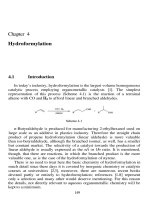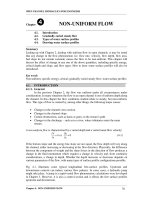Chapter 4 lipid 2015817
Bạn đang xem bản rút gọn của tài liệu. Xem và tải ngay bản đầy đủ của tài liệu tại đây (1.31 MB, 38 trang )
Chuyển hóa lipid (degradation, catabolism)
• Thủy phân
• Oxy hóa khử sinh học
• Các enzym thủy phân lipid:
– Lipase
– Phospholipase A,B,C,D
• Các sản phẩm thủy phân:
– Glycerol
– Axit béo
Entry of glycerol into the glycolytic pathway
Chuyển hóa của axit béo
Chu trình -oxy hóa axit béo (Knoop)
• Các axit béo mạch thẳng, số chẵn nguyên tử C
• Các axit béo no
• Các axit béo không no
α -Oxy hóa
• Oxy hóa axít béo số C lẻ
Fatty acid beta oxidation
CAPILLARY
lipoproteins
LPL
FA
FA
albumin
FA
1
From fat cell
2
FA
MITOCHONDRION
FABP
FA
3
4
FABP
acyl-CoA
FABP
FA
CYTOPLASM
cell membrane
A
C
S
TCA
cycle 7
-oxidation
6
acyl-CoA
acetyl-CoA
5
carnitine
transporter
FA = fatty acid
LPL = lipoprotein lipase
FABP = fatty acid binding protein
ACS = acyl CoA synthetase
Conversion of a fatty acid to an acyl-CoA
β-Oxidation of Acyl-CoA to aceyl-CoA
Steps in Beta Oxidation
• Fatty Acid Activation by esterification with
CoASH
• Membrane Transport of Fatty Acyl CoA Esters
• Carbon Backbone Reaction Sequence
•
•
•
•
Dehydrogenation
Hydration
Dehydrogenation
Thiolase Reaction (Carbon-Carbon Cleavage)
1. Activation of Fatty Acids
• Acyl CoA synthetase reaction occurs on the
mitochondrial membrane
2.Transport into Mitochondrial Matrix
• Carnitine carries
long-chain
activated fatty
acids into the
mitochondrial
matrix
• Carnitine carries long-chain activated fatty
acids into the mitochondrial matrix
3. Fatty acid Beta oxidation
• Each round in fatty
acid degradation
involves four reactions
– 1. oxidation to
trans-∆2-Enoly-CoA
Removes H atoms from the
and carbons
-Forms a trans C=C bond
-Reduces FAD to FADH2
2. Hydration to L–3–
Hydroxylacyl CoA
– Adds water across the
trans C=C bond
– Forms a hydroxyl group
(—OH) on the carbon
3. Oxidation to
– 3–Ketoacyl CoA
– Oxidizes the hydroxyl
group
– Forms a keto group on the
carbon
4. Thiolysis to produce
Acetyl–CoA
– acetyl CoA is cleaved:By
splitting the bond between
the and carbons.
– To form a shortened fatty
acyl CoA that repeats steps
1 - 4 of -oxidation
Cycles of -Oxidation
The length of a fatty acid
• Determines the number of oxidations and the total
number of acetyl CoA groups
Carbons in Acetyl CoA
-Oxidation Cycles
Fatty Acid
(C/2)
(C/2 –1)
12
6
5
14
7
6
16
8
7
18
9
8
-Oxidation and ATP
Activation of a fatty acid requires:
2 ATP
One cycle of oxidation of a fatty acid produces:
1 NADH
3 ATP
1 FADH2
2 ATP
Acetyl CoA entering the citric acid cycle produces:
1 Acetyl CoA
12 ATP
ATP for Myristic Acid C14
ATP production for Myristic(14 carbons):
Activation of myristic acid
-2 ATP
7 Acetyl CoA
7 acetyl CoA x 12 ATP/acetyl CoA
84 ATP
6 Oxidation cycles
6 NADH x 3ATP/NADH
18 ATP
6 FADH2 x 2ATP/FADH2
12 ATP
Total
112 ATP
The β-oxidation pathway of Palmitic acid
The β-Oxidation of Saturated Fatty
Acids: 4 Basic Steps
from Palmitoyl-CoA
Oxidation of Fatty Acids









